Robert Bielik emerged on the Slovak art scene in the 1990s when painting as an artistic form was marginalized and the interest of artists and theoreticians switched to the trendy new media such as installation, video, performance and so on. In spite of that he decided to work with classical, narrative, figurative and realistic oil painting, following his own rules not considering current tendencies or preferences. He uses in his works principles and techniques of historical painting (renaissance, baroque, romanticism) together with new technologies (photography and computer manipulated images). At the first glance some critics can say that his works border with kitsch, however, as he admits, he paints nice paintings that appease to people’s taste. He draws inspiration from the antique period, Christianity, Eastern philosophies and philosophy in general, from his own travel experiences, his worldview, attitudes and internal meditations. He also appropriates postmodernist eclecticism borrowing of motifs from art history; he revels in paradoxes and employs irony and self-irony. A recurrent motif in his works is still-life, where he permutes objects from the past and present, landscapes with naked figures in rigorous positions, angels, children, portraits (of people he relates to), clouds, water, animals (most frequently tigers, rabbits, wolves, sheep), ornaments, skulls, planes, books, flames, landscapes, city views, but also motifs of death, old age, transience and melancholy.
The oil painting Boy with Skulls (Chlapec a lebky) shows a section of an unidentified space with two shelves and dozens of skulls. We can see a small boy from behind as he peeks over, leaning on his tiptoes as if he wanted to see what is hidden on the highest shelf that he cannot reach to. This relatively morbid scene reminds us of mass grave yards in ancient catacombs or ossuaries where hundreds of anonymous bones or skulls are piled (often in ornamental positions). The selected color scale in gray and blue shades accentuates the atmosphere. The scene is built on a contrast between death (skulls) and life (the small boy) that inseparably belong to one another. The scene discloses typical human quality; curiosity – thanks to which we ask questions about life and death, the meaning of life and what follows after. Human skull, an ancient art motif symbolizing death, was favored in the paintings called vanitas, Flemish and Dutch still-lives from the 16th and 17th centuries depicting symbolical objects such as skulls, hourglasses, books, putrefying fruits, etc., pointing to vanity of human existence, transience of human life and the inevitability of death.
For Bielik it is important to realize the temporality of one’s being and the inevitability of one’s death in the context of abandoning one’s desires that are according to him the sources of suffering. As he writes about himself: “That boy, who I had been, often used to think about death. The recurring remembrance of death has always been considered as a marker of one’s intelligence. People have ritualized death, dramatized, paid respects to it and mostly tried to escape from it; therefore they annul and silence it today. A fool exchanges the fact that we are mortal for one’s ambition and wants to accomplish oneself. And then it is said that the world has it so and so.” [1]
Robert Bielik was born in 1963 in Levice, Slovakia. From 1987 to 1993 he studied at the Academy of Fine Arts and design in Bratislava in the Open Studio of Professor Rudolf Sikora. Since 1994 he has held a teaching position at the Art Department of the Pedagogical Faculty of the Constantine the Philosopher University in Nitra. He illustrated seven books for the publishing houses of Slovenský spisovateľ, Smena, Eugenica and Petrus. He published several books of poetry, prose and essays. In addition to painting and writing he likes traveling and with the exception of Antarctica and Australia he visited all continents, most often he returns to Indochina and India. He lives and works in Bratislava.
—Omar Mirza
Notes
[1] Bielik, Robert: Sansilia, Petrus, Bratislava 2006, pg. 46, quoted according to: Jančár, Ivan: Robert Bielik, Bratislava City Gallery and Petrus Publishing House, Bratislava 2012, pg. 7.
Inventory No.: O–2142
Artist: Robert Bielik
Title: Boy with Sculls
Year of origin: 2007
Technique: oil
Material: canvas
Dimensions: 150 × 170 cm
Signature: in the right bottom corner with a red stamp: RB
This acquisition has been supported using public funds provided by the Ministry of Culture of the Slovak Republic.
